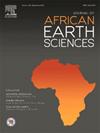Late Cenozoic updated foraminiferal stratigraphic and palaeoenvironmental framework for the southwestern shelf of Africa
IF 2.2
4区 地球科学
Q2 GEOSCIENCES, MULTIDISCIPLINARY
引用次数: 0
Abstract
Marine sediments from the western shelf of southern Africa provide key information on the stratigraphy and palaeoenvironment of the region. Palaeoenvironmental research on Miocene shelf foraminifera is fragmentary. An understanding of the stratigraphy and palaeoenvironment can inform on exploration studies and climatic impact on marine sedimentation. Two marine cores (core 128 at 262 m; core 1408 at 303 m water depth) from the western shelf of South Africa and Namibia were studied for their strontium isotope (87Sr/86Sr ratios) stratigraphy, foraminiferal biostratigraphy and microscopy. Five depositional units based on their sedimentary and mineral compositions occur in core 128, namely: foraminifera-rich sand; black pelletal phosphorite unit I; glauco-phosphatic unit; calcareous glauco-phosphatic unit and black pelletal phosphorite unit II. Core 1408 contained three main units, namely: foraminifera-rich mud; brown-black phosphorite unit and shelly phosphorite unit. The palaeoenvironment of core 128, based on foraminiferal ecological indicators, show a relatively deeper marine, nutrient-rich environment in the early Miocene (20.45 Ma; indicator species Globigerina praebulloides and Globigerina falconensis), while late Miocene foraminifera in the basal foraminifera-rich mud unit (9.80–5.80 Ma; indicator species Globoquadrina dehiscens) of core 1408 revealed a slightly more oxygenated environment with warmer conditions. Phosphorites and shallow water foraminifera dated to the Pleistocene (2.72–1.09 Ma; indicator species Globoconella inflata and Globorotalia truncatulinoides) in both cores indicate eutrophic conditions and high productivity. Fragmentation of tests (19–54 %) are interpreted to be as a result of upwelling and transport under increasing sea-level amplitude. These two records support key environmental characteristics from upwelling conditions and major temperate water influence in the early Miocene to major fluvial influence in the Pliocene, and strong upwelling and eutrophic conditions in the Pleistocene.
求助全文
约1分钟内获得全文
求助全文
来源期刊

Journal of African Earth Sciences
地学-地球科学综合
CiteScore
4.70
自引率
4.30%
发文量
240
审稿时长
12 months
期刊介绍:
The Journal of African Earth Sciences sees itself as the prime geological journal for all aspects of the Earth Sciences about the African plate. Papers dealing with peripheral areas are welcome if they demonstrate a tight link with Africa.
The Journal publishes high quality, peer-reviewed scientific papers. It is devoted primarily to research papers but short communications relating to new developments of broad interest, reviews and book reviews will also be considered. Papers must have international appeal and should present work of more regional than local significance and dealing with well identified and justified scientific questions. Specialised technical papers, analytical or exploration reports must be avoided. Papers on applied geology should preferably be linked to such core disciplines and must be addressed to a more general geoscientific audience.
 求助内容:
求助内容: 应助结果提醒方式:
应助结果提醒方式:


